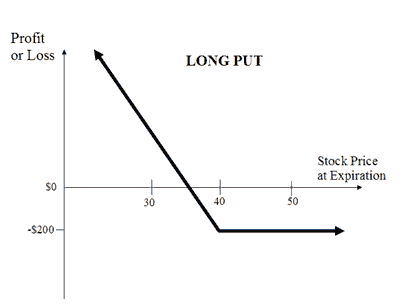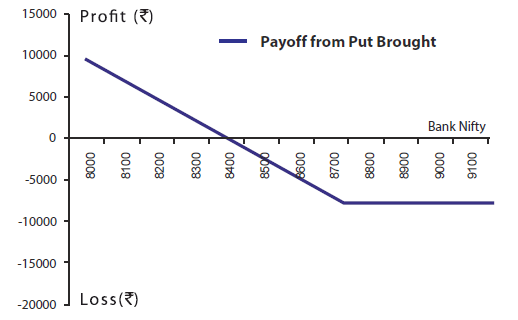 Zerodha (Trading & Demat Account)
Zerodha (Trading & Demat Account)
FREE Equity Delivery and MF
Flat ₹20/trade Intra-day/F&O
 Zerodha (Trading & Demat Account)
Zerodha (Trading & Demat Account)
FREE Equity Delivery and MF
Flat ₹20/trade Intra-day/F&O

|
|
Published on Thursday, April 19, 2018 | Modified on Monday, April 26, 2021

| Strategy Level | Beginners |
| Instruments Traded | Put |
| Number of Positions | 1 |
| Market View | Bearish |
| Risk Profile | Limited |
| Reward Profile | Unlimited |
| Breakeven Point | Strike Price of Long Put - Premium Paid |
A Long Put strategy is a basic strategy with the Bearish market view. Long Put is the opposite of Long Call. Here you are trying to take a position to benefit from the fall in the price of the underlying asset. The risk is limited to premium while rewards are unlimited.
Long put strategy is similar to short selling a stock. This strategy has many advantages over short selling. This includes the maximum risk is the premium paid and lower investment. The challenge with this strategy is that options have an expiry, unlike stocks which you can hold as long as you want.
Let's assume you are bearish on NIFTY and expects its price to fall. You can deploy a Long Put strategy by buying an ATM PUT Option of NIFTY. If the price of NIFTY shares falls, the put option will now be in-the-money with an intrinsic value. This could result in unlimited profits. However, if the price of NIFTY rises, the put option will expire worthlessly and the maximum loss incurred will be the premium paid.
This strategy has limited risk and unlimited rewards.
The long put strategy looks like as below for NIFTY which is currently traded at Rs 10400 (NIFTY Spot Price):
| Orders | NIFTY Strike Price |
|---|---|
| Buy 1 ATM Put | NIFTY18APR10400PE |
Suppose NIFTY shares are trading at 10400. If we are expecting the price of NIFTY to go down in near future, we buy 1 NIFTY Put Option to implement this strategy.
If NIFTY falls as we expected, the put option will be in-the-money and we will make profits from it. There is a potential for unlimited profits in this scenario.
If NIFTY rises, the put option expires worthless. We lose the premium paid initially to get into this trade. This is also the maximum loss scenario.
A long put option strategy works well when you're expecting the underlying asset to sharply decline or be volatile in near future.
Let's take a simple example of a stock trading at Rs 40 (spot price) in June. The option contracts for this stock are available at the premium of:
Lot size: 100 shares in 1 lot
Net Debit: Rs 200
Now let's discuss the possible scenarios:
Scenario 1: Stock price remains unchanged at Rs 44
In this scenario, we lost total Rs 200 which is also the maximum loss in this strategy.
Scenario 2: Stock price goes up to Rs 50
Same as scenario 1:
In this scenario, we lost total Rs 200 which is also the maximum loss in this strategy.
Scenario 3: Stock price goes down to Rs 30
This profit rises as the price of the underlying asset fall further.
| Bank Nifty Spot Price | 8900 |
| Bank Nifty Lot Size | 25 |
| Strike Price(Rs ) | Premium(Rs ) | Total Premium Paid(Rs ) (Premium * lot size 25) | |
|---|---|---|---|
| Buy 1 Put Option | 8800 | 400 | 10000 |
| Net Premium | 400 | 10000 | |
| Breakeven(Rs ) | Strike price of the Long Put - Net Premium (8800 - 400) | 8400 |
| Maximum Possible Loss (Rs ) | Net Premium Paid * Lot Size (400*25) | 10000 |
| Maximum Possible Profit (Rs ) | Unlimited | Unlimited |
| On Expiry Bank NIFTY closes at | Net Payoff from 1 Put Options Brought (Rs ) @8800 | Net Payoff (Rs ) |
|---|---|---|
| 8000 | 20000 (8800-8000)*25 | 10000 20000-10000 |
| 8200 | 15000 (8800-8200)*25 | 5000 15000-10000 |
| 8400 | 10000 (8800-8400)*25 | 0 10000-10000 |
| 8600 | -5000 (8800-8600)*25 | -5000 5000-10000 |
| 8800 | 0 | -10000 0-10000 |
| 9000 | 0 | -10000 0-10000 |

When you are expecting a drop in the price of the underlying and rise in the volatility.
Let's assume you're Bearish on Nifty currently trading at 10,400. You expect it to fall to 10,000 level. You buy a Put option with a strike price 10,000. If the Nifty goes below 10,000, you will make a profit on exercising the option. In case the Nifty rises contrary to expectation, you will incur a maximum loss of the premium.
Strike Price of Long Put - Premium Paid
The breakeven is achieved when the strike price of the Put Option is equal to the premium paid.
The risk for this strategy is limited to the premium paid for the Put Option. Maximum loss will happen when price of underlying is greater than strike price of the Put option.
This strategy has the potential to earn unlimited profit. The profit will depend on how low the price of the underlying drops.
Underlying goes down and Option exercised
Underlying goes up and Option not exercised
Unlimited profit potential with risk only limited to loss of premium.
You may incur 100% loss in premium if the underlying price rises.

Add a public comment...

FREE Intraday Trading (Eq, F&O)
Flat ₹20 Per Trade in F&O
|
|